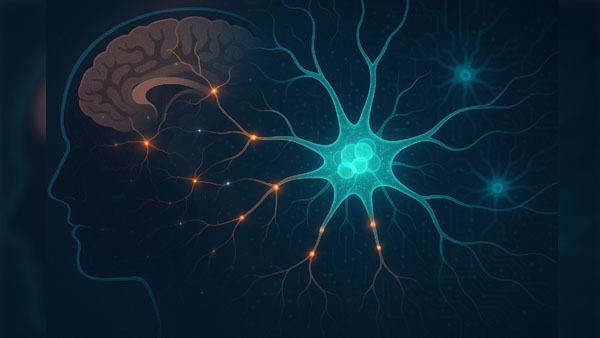By Satyabrat Borah
The human brain, a marvel of biological engineering, contains approximately 86 billion neurons, the cells responsible for transmitting electrical signals that enable us to think, feel, and store memories. These neurons form intricate networks, connecting through synapses to process and retain vast amounts of information. For decades, scientists focused primarily on neurons to unravel the mysteries of memory and cognition. However, the brain also houses billions of other cells, known as astrocytes, which have long been relegated to a supporting role. Recent research from the Massachusetts Institute of Technology (MIT) challenges this view, proposing a groundbreaking theory that positions astrocytes as key players in memory storage and potentially explaining the brain’s extraordinary capacity to hold information.
Astrocytes, named for their star-shaped appearance, are glial cells with long, branching arms that allow them to interact with hundreds of thousands, even millions, of synapses. Traditionally, scientists believed these cells merely supported neurons by clearing debris, supplying nutrients, and ensuring a steady flow of oxygen through blood vessels. This perspective painted astrocytes as the brain’s maintenance crew, quietly working in the background to keep neurons functional. But emerging evidence suggests their role extends far beyond housekeeping. A team of MIT researchers, led by Dmitry Krotov from the MIT-IBM Watson AI Lab, with contributions from Jean-Jacques Slotine, a professor of mechanical engineering and brain and cognitive sciences, and first author Leo Kozachkov, a 2022 MIT PhD graduate, has developed a novel model. Published in the Proceedings of the National Academy of Sciences, their work highlights how astrocytes might actively contribute to the brain’s ability to store and process memories.
The human brain’s capacity to retain information is staggering. We store countless experiences, facts, faces, and skills, far exceeding what simple neuron-to-neuron connections might account for. If memory relied solely on the 86 billion neurons and their synapses, the storage potential would be limited. Yet, the brain manages to encode and recall a lifetime of data with remarkable efficiency. This discrepancy has long puzzled neuroscientists, prompting the MIT team to explore whether astrocytes could bridge the gap. Jean-Jacques Slotine notes that evolution likely recognized the potential of astrocytes, given their ability to connect with vast numbers of synapses. Rather than merely cleaning up after neurons, these cells might engage in computation and information processing, fundamentally reshaping our understanding of brain function.
Astrocytes perform several critical tasks. They remove waste, deliver nutrients, and regulate blood flow to ensure neurons have the oxygen and energy they need. Their delicate, tentacle-like extensions wrap around synapses, the junctions where neurons exchange signals. This arrangement forms what scientists call a tripartite synapse, involving two neurons and one astrocyte. Unlike neurons, which communicate via electrical impulses, astrocytes use calcium signals to interact with their environment. Researchers have observed that these calcium waves synchronize with neural activity, suggesting a dynamic partnership. When neurons fire, astrocytes respond by adjusting their calcium levels, triggering the release of chemicals known as gliotransmitters. These molecules can influence synaptic strength, either enhancing or weakening connections between neurons.
To explore this interaction, the MIT team turned to computational modeling, building on a framework called Hopfield networks. These artificial neural networks, developed in the 1980s, attempt to mimic how the brain stores and retrieves patterns, such as memories. Traditional Hopfield networks, however, fall short in explaining the brain’s immense storage capacity. A single neuron connects to others through synapses, but the number and complexity of these connections are insufficient to account for the brain’s capabilities. To address this, the researchers adopted an advanced version known as dense associative memory. This model allows for more intricate connections, enabling the storage of significantly more patterns and information than its predecessor.
The challenge lies in how the brain achieves such complex connectivity. Typical synapses link just two neurons, limiting the scope of interactions. Here, astrocytes offer a compelling solution. With their branching arms, these cells can interact with multiple synapses simultaneously, facilitating connections across a vast network of neurons. The MIT model proposes that astrocytes act as a bridge, enabling intricate, multi-neuron interactions that boost memory storage. By modulating synaptic activity through gliotransmitters and calcium signaling, astrocytes could fine-tune the strength and patterns of neural connections. This mechanism suggests the brain leverages astrocytes to create a dense, interconnected web, vastly increasing its capacity to encode information.
Consider the implications of this idea. If astrocytes actively participate in memory, they transform from passive supporters to dynamic contributors. The model indicates that their ability to coordinate across numerous synapses allows the brain to store far more data than a neuron-only system could manage. This could explain how we retain detailed memories of childhood events, complex skills like playing an instrument, or vast repositories of facts accumulated over decades. The synergy between neurons and astrocytes might be the key to the brain’s remarkable efficiency, allowing it to compress and organize information in ways we are only beginning to comprehend.
Testing this theory presents a significant challenge. To confirm the role of astrocytes, scientists would need to manipulate their interactions with neurons and observe the effects on memory. This could involve advanced techniques, such as optogenetics, to control astrocyte activity with light, or genetic tools to alter their calcium signaling. If disrupting these connections impairs memory formation or recall, it would provide strong evidence for the model. Conversely, enhancing astrocyte function might reveal whether memory capacity or clarity improves. Such experiments are complex, as the brain’s delicate balance makes it difficult to isolate the contributions of one cell type without affecting others. Yet, advances in imaging and molecular biology are bringing researchers closer to answering these questions.
This discovery holds promise for artificial intelligence. Early AI models drew inspiration from the brain, with neural networks mimicking neuron-like connections. Modern AI systems have diverged from biological principles, relying on massive datasets and computational power to achieve results. The MIT findings could bridge this gap. By incorporating astrocyte-like mechanisms, engineers might design AI systems that store and process information more efficiently. For instance, a network that mimics the multi-connection role of astrocytes could handle complex patterns with less energy, a critical goal in an era of growing computational demands. Jean-Jacques Slotine emphasizes this potential, noting that while AI originated from neuroscience, recent models have strayed from biology. This research could realign the two fields, leading to smarter, more brain-like systems.
The implications extend further. Understanding how astrocytes contribute to memory could shed light on neurological disorders. Conditions like Alzheimer’s disease, which impair memory, might involve disruptions in astrocyte function. If these cells fail to regulate synapses or clear debris effectively, it could contribute to cognitive decline. Therapies targeting astrocytes, such as drugs to enhance their signaling or repair their interactions, might offer new avenues for treatment. Similarly, insights from this model could inform research into epilepsy, where abnormal neural activity often involves glial cells, or traumatic brain injuries, where astrocytes play a role in repair and inflammation.
This groundbreaking theory also invites us to rethink the brain’s complexity. For too long, astrocytes were overlooked, dismissed as mere support staff. Now, they emerge as potential co-architects of memory, working alongside neurons to create the rich tapestry of our minds. The MIT model underscores the brain’s collaborative nature, where diverse cell types interact in sophisticated ways. It challenges the neuron-centric view, urging scientists to explore the broader ecosystem of the brain.
As research progresses, the role of astrocytes will likely become clearer. Future studies might reveal how they encode specific types of memories like episodic, procedural, or emotional or how they adapt to learning over time. The intersection of neuroscience and technology also promises exciting developments, potentially leading to AI that mirrors the brain’s efficiency and resilience. For now, the MIT team’s work marks a pivotal step, illuminating a hidden dimension of brain function. By recognizing astrocytes as active participants in memory, we move closer to unraveling the enigma of the human mind and harnessing its strategies for innovation. The journey to understand the brain’s full potential is far from over, but with astrocytes in the spotlight, a new frontier in neuroscience has begun.




